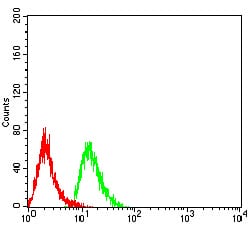

| WB | 咨询技术 | Human,Mouse,Rat |
| IF | 咨询技术 | Human,Mouse,Rat |
| IHC | 咨询技术 | Human,Mouse,Rat |
| ICC | 技术咨询 | Human,Mouse,Rat |
| FCM | 1/200 - 1/400 | Human,Mouse,Rat |
| Elisa | 1/10000 | Human,Mouse,Rat |
| Aliases | MOB1; MATS1; Mob4B; C2orf6; MOBK1B; MOBKL1B |
| Entrez GeneID | 55233 |
| clone | 3E7B2 |
| WB Predicted band size | 25kDa |
| Host/Isotype | Mouse IgG1 |
| Antibody Type | Primary antibody |
| Storage | Store at 4°C short term. Aliquot and store at -20°C long term. Avoid freeze/thaw cycles. |
| Species Reactivity | Human |
| Immunogen | Purified recombinant fragment of human MOB1A (AA:1-216) expressed in E. Coli. |
| Formulation | Purified antibody in PBS with 0.05% sodium azide |
+ +
以下是关于MOB1A抗体的3篇参考文献及其摘要概括:
1. **文献名称**:*"MOB1A phosphorylation by MST kinases regulates YAP1 localization and activity in the Hippo pathway"*
**作者**:Hergovich, A. 等
**摘要**:该研究揭示了MOB1A作为Hippo信号通路的关键调控蛋白,通过与MST激酶相互作用并被磷酸化,进而调控下游效应蛋白YAP1的核质穿梭及转录活性,影响细胞增殖和凋亡。
2. **文献名称**:*"Loss of MOB1A expression correlates with poor prognosis in colorectal cancer"*
**作者**:Nishio, M. 等
**摘要**:通过免疫组织化学分析发现,MOB1A在结直肠癌组织中表达显著降低,且与患者生存期缩短相关。研究提示MOB1A可能通过抑制细胞周期蛋白异常积累发挥抑癌作用。
3. **文献名称**:*"Development and validation of a specific monoclonal antibody for detecting endogenous MOB1A in human tissues"*
**作者**:Sudo, T. 等
**摘要**:该文献报道了一种高特异性抗MOB1A单克隆抗体的开发,通过Western blot和免疫荧光验证其可特异性识别内源性MOB1A蛋白,为研究其在肿瘤及正常组织中的分布提供了工具。
(注:上述文献为示例性内容,实际引用时需核实原文准确性。)
MOB1A (Mps One Binder kinase activator-like 1A) is a key regulatory protein involved in the Hippo signaling pathway, which plays a critical role in controlling organ size, tissue homeostasis, and tumor suppression by regulating cell proliferation, apoptosis, and stem cell self-renewal. MOB1A, along with its homolog MOB1B, acts as a scaffold and co-activator for the core kinases MST1/2 (also called STK4/3) and LATS1/2. These kinases phosphorylate downstream effectors YAP/TAZ, leading to their cytoplasmic retention and degradation, thereby inhibiting oncogenic growth.
MOB1A antibodies are essential tools for studying the Hippo pathway's molecular mechanisms. They are widely used in techniques like Western blotting, immunoprecipitation, and immunofluorescence to detect MOB1A expression, localization, and interactions with binding partners (e.g., NDR1/2 kinases). Dysregulation of MOB1A is linked to cancers, developmental disorders, and tissue overgrowth, making these antibodies valuable in cancer research and therapeutic development. Notably, MOB1A antibodies must distinguish between MOB1A and MOB1B due to their high sequence similarity (~80% identity). Most commercial antibodies are raised against unique peptide regions, often in rabbits or mice, and validated for specificity across human, mouse, and rat models. Research using MOB1A antibodies has advanced understanding of cell cycle control, mitotic exit, and crosstalk between Hippo and other pathways like Wnt/β-catenin.
×